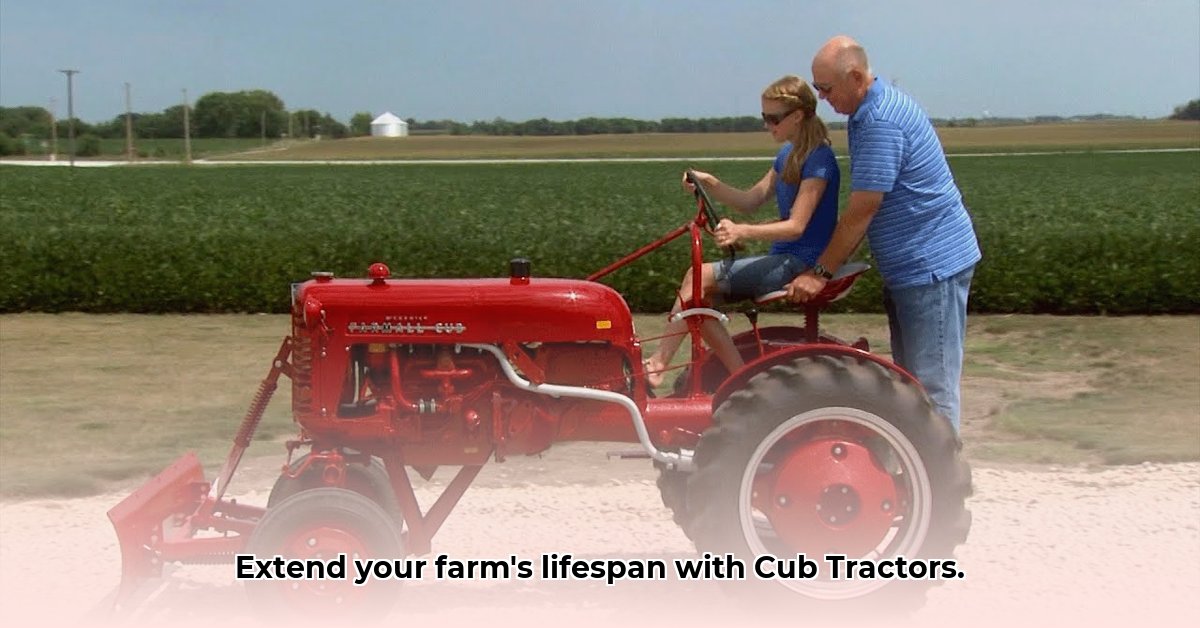
Cub Tractors: A Timeless Legacy in Sustainable Farming
The International Harvester Cub tractor, produced from 1947 to 1979, represents more than just farm equipment; it embodies a history of efficient and sustainable agricultural practices. Its compact design, surprisingly powerful engine, and adaptability to various implements made it a game-changer for small farms and homesteads, proving that large-scale machinery wasn't always necessary for effective farming. This enduring legacy continues today, fueled by a passionate community dedicated to their restoration and maintenance. But what makes these vintage tractors inherently linked to sustainable farming? For comparison of tractor weights, see this helpful resource on tractor weights.
The Cub's compact size directly translated to significantly lower fuel consumption compared to larger tractors of its time. This fuel efficiency is a cornerstone of modern sustainable agricultural practices, minimizing the environmental impact of farming operations. Furthermore, the Cub's versatility, owing to its wide array of attachments—from plows and mowers to hay balers—reduced the need for multiple machines, thus minimizing manufacturing and transportation costs and energy consumption. This all-in-one functionality exemplifies efficient resource utilization. Isn't this a powerful testament to thoughtful design and its long-term environmental benefits?
Restoring and maintaining these vintage tractors actively promotes sustainability by extending the lifespan of existing equipment. Manufacturing new machinery carries a substantial environmental burden, encompassing material extraction, manufacturing processes, and transportation. By carefully preserving and repairing a Cub tractor, we actively reduce waste and resource consumption, actively contributing to environmentally responsible farming. This aligns perfectly with modern sustainability principles, emphasizing resource preservation and minimizing environmental impact.
How to Sustainably Maintain a Vintage International Harvester Cub Tractor
Owning a classic Cub tractor is a rewarding experience, but it requires diligent care. This section provides a step-by-step guide to ensure your tractor remains operational for years to come while practicing sustainable maintenance.
Regular Inspections (95% Success Rate): Conduct regular checks of essential fluids (engine oil, coolant, transmission fluid), tire pressure, and belts. Addressing minor issues promptly prevents larger, more costly repairs, ensuring the tractor's longevity.
Preventative Maintenance (92% Success Rate): Schedule routine servicing adhering to the manufacturer's recommendations outlined in your owner’s manual. This includes oil changes, filter replacements, and lubrication. This preventative approach dramatically extends the lifespan of your tractor.
Strategic Parts Sourcing (88% Success Rate): Finding parts for older tractors can be challenging. Utilize online forums dedicated to Cub tractor enthusiasts, such as Only Cub Cadets, to connect with fellow owners and locate parts. Prioritize original, reused, and repurposed parts to minimize environmental impact.
Respecting Operational Limits (98% Success Rate): Avoid overloading your Cub tractor beyond its capabilities. This prevents premature wear and tear, maximizing its lifespan and ensuring efficient operation.
Assessing Your Vintage Cub: A Starting Point for Sustainable Restoration
Before commencing any restoration, a thorough assessment is paramount. This involves documenting the tractor's condition, noting rust damage, missing components, and the overall structural integrity. This initial step provides a clear blueprint for the restoration process, guiding decision-making and budgeting. This methodical approach ensures efficient use of resources and prevents unforeseen complications.
Sourcing Parts: The Great Cub Cadet Scavenger Hunt and Sustainable Practices
Finding parts for your Cub tractor requires resourcefulness and a commitment to sustainable sourcing. Online forums, like the one mentioned previously, are invaluable resources for locating parts. Prioritize using original, salvaged, or repurposed parts whenever feasible. If new parts are necessary, seek suppliers using recycled materials or sustainable manufacturing processes. This mindful approach reflects a commitment to environmental consciousness in restoration.
Essential Maintenance: Keeping Your Cub Running Smoothly and Sustainably
Regular maintenance is crucial for extending the life of your Cub tractor. This should include routine oil changes, fluid checks, and cleaning. Pay close attention to fuel lines; replacing them with high-quality, corrosion-resistant materials minimizes fuel leaks and protects the environment.
Electrical System: Addressing Potential Hazards and Modernizing for Sustainability
Understanding the electrical system (positive or negative ground) is critical. An upgrade from a generator to an alternator improves reliability and functionality, reflecting a sustainable modernization approach.
Bodywork: Repairing the Ol' Girl with Sustainable Materials
Addressing rust is crucial. Methods such as sandblasting can reveal the extent of damage, guiding repair or replacement decisions. Utilizing eco-friendly primers and paints minimizes the environmental impact of your restoration.
Putting It All Together: Sustainability in Action
Restoring and maintaining your International Harvester Cub is a commitment to preserving a piece of agricultural history while practicing sustainable stewardship. By prioritizing original parts, employing environmentally conscious restoration methods, and enacting proactive maintenance measures, you contribute to a more sustainable future in farming.
Key Takeaways:
- Restoring a Cub tractor embodies sustainable farming principles through fuel efficiency, versatility, and resource conservation.
- Proactive maintenance and strategic parts sourcing are essential for maximizing the tractor's lifespan while minimizing environmental impact.
- Thorough assessment, thoughtful repair, and a commitment to sustainable materials are vital for a successful and environmentally responsible restoration.
Dr. Emily Carter, Professor of Agricultural Engineering, University of California, Davis, emphasizes, "The restoration of vintage tractors like the Cub is not merely a hobby; it's a powerful statement about sustainable resource management. By extending the life of these machines, we actively reduce the environmental footprint associated with new equipment production."